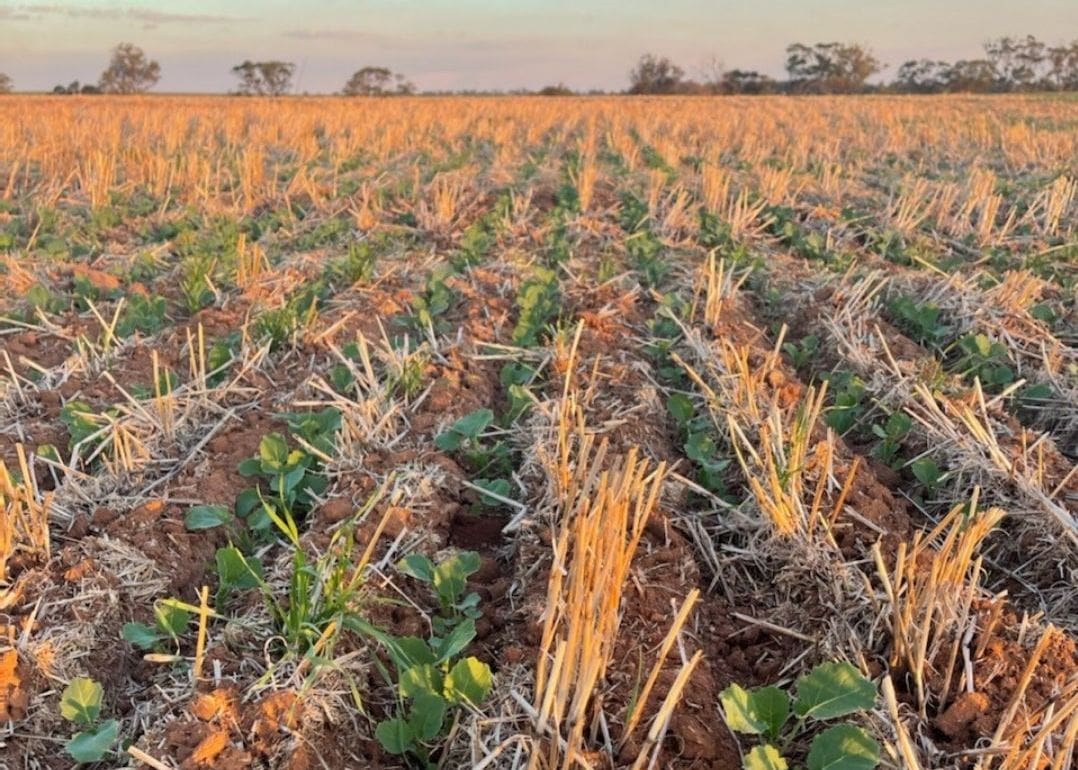
A crop of Pioneer 44Y30RR canola off to a strong start at Calingiri, WA. Photo: John Young
A STRONG and early start to winter-crop planting coupled with strong price prospects has piled on some upside to area for Australia’s three biggest winter crops, wheat, barley and canola.
While conditions range from dry in South Australia to sodden in parts of New South Wales and Queensland, most growers are around one third to halfway through their sowing programs.
Consensus is that most of Australia’s canola area has been planted, with growers now making headway on wheat, and barley planting yet to start in most regions.
In its March forecast for new-crop area and production, ABARES tipped a 5-per-cent drop in 2022-23 wheat hectares from the 2021-22 area resulting in a crop which weighed in at a record 36.3 million tonnes (Mt).
While ABARES March forecast put new-crop wheat area at 12.3M hectares (Mha), Australian Crop Forecasters preliminary estimate is 13.3Mha, with Lachstock Consulting on 14.6Mha.
ACF and Lachstock’s forecasts have been issued in light of Russia’s invasion of Ukraine, which has driven up world oilseed and grain prices because of the conflict’s impact on Ukrainian exports out of the Black Sea, and new-crop production prospects.
ABARES forecasts, due to be updated in its next Australian Crop Report on June 7, are therefore seen as having some upside based on strong prices and an early start to sowing amid favourable moisture profiles for most growers.
| 2021-22 ha | Tonnes | Exports | 2022-23 ha | Tonnes | Exports | |
| Wheat | 13,039,000 | 36,347,000 | 25,297,000 | 12,325,000 | 27,993,000 | 21,000,000 |
| Barley | 4,357,000 | 13,724,000 | 8,707,000 | 4,293,000 | 11,034,000 | 7,094,000 |
| Canola | 3,045,000 | 6,352,000 | 5,337,000 | 3,140,000 | 4,933,000 | 3,979,000 |
Table 1: ABARES’ 2021-22 actual area, production and export figures, and forecasts for 2022-23.
| ABARES | ACF | Lachstock | |
| Wheat | 12,325,000 | 13,340,000 | 14,648,000 |
| Barley | 4,293,000 | 4,300,000 | 3,852,000 |
| Canola | 3,140,000 | 3,090,000 | 3,373,000 |
| TOTAL AREA | 19,758,000 | 20,730,000 | 21,873,000 |
Table 2: ABARES, Australian Crop Forecasters and Lachstock Consulting forecast hectares for major Australian 2022-23 winter crops now being planted. Source: ABARES, Australian Crop Forecasters, Lachstock Consulting.
Widespread rain across the Western and eastern Australian grainbelt is forecast to fall by mid next week, with only South Australia expected to miss out on falls of 10 millimetres or more ahead of the front now moving across central Australia.
North well into wheat
Growers in Queensland and northern New South Wales are roughly one third through their wheat-planting programs.
In northern NSW, most growers have finished planting faba beans and canola, and will move on to barley, chickpeas and durum once all their wheat is in the ground.
In Central Queensland (CQ), Nutrien Ag Solutions Emerald agronomist Darren Young said growers were roughly one quarter to halfway through their barley and wheat planting programs.
CQ is typically Australia’s earliest region to harvest, with first crops likely to hit the bins in September.
Mr Young said rain in the past week or two had delivered 30-70 millimetres for most growers.
“Most people have breaks somewhere in that range, and the rain was pretty widespread a week or two ago,” Mr Young said
“A few blokes have pulled up, waiting for this next rain, and there’s a lot more wheat to go before they move on to chickpeas.”
At Moree, Delta Agribusiness agronomist Rob Long said planting activity is frantic ahead of the 20mm plus forecast for coming days,
“Everyone’s going absolutely flat stick at the moment because there’s rain coming.
“It’s mainly been showers so far, and some pockets had 20mm, so that’s held them up, but most of the district has had 5-10mm, and they’ve been able to get a start again.”
Mr Long said strong prices and rain which has enabled an early start to sowing have provided “plenty of incentive” for croppers, and growers had finished planting canola and faba beans and were now into main-season wheats.
Southern, western regions mixed
On lighter soils in central and southern NSW and Victoria, growers have mostly finished planting canola, and are moving on to cereals and pulses.
A lack of follow-up rain following good falls last month has slowed or stopped seeding in parts of Western Australia, where again most canola is in the ground.
South Australia, with the possible exception of the Lower Eyre Peninsula, has had light falls to date, but growers including Linden Price at Narridy in SA’s Mid North are dry sowing ahead of rain expected by early June.
Mr Price said he was well into planting the family’s wheat, barley and lentils, and had not seen a good double-digit rainfall event since January.
“We’ve had 2s and 3s and 5s, and that’s normal for this time of year.
“It’s just a classic South Australian break.”
SA growing areas are generally close to the coast, and therefore pick up showers as in-crop rainfall to supplement subsoil moisture reserves.
In Victoria, growers have also mostly finished their canola, and are moving on to planting wheat and pulses.



HAVE YOUR SAY